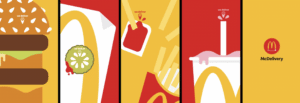When times are hard, brands win by making people’s lives easier
The cost-of-living crisis means we are all getting less for our money. For everyone, except the most affluent few, there is one thing people have more of during hard times; decisions to make.
People are more likely to need to choose between a takeaway or going to the cinema. If they can afford their Netflix subscription. Whether to drive to see a friend and use half a tank of petrol, or not. If they should start shopping at a different supermarket to save money or trade down from a brand to entry price own label.
The less money you have, the more decisions you need to make each day. And every decision made takes a physical toll. The brain uses around 20% of your daily calories, and we want to save our energy where we can so we avoid decisions if it’s possible. It’s why so much of our behaviour is habitual. Habits remove the need to decide what to do next.
So, in times when the number of decisions people need make is going up, the brands that make life easier for people by removing decisions – being the ‘no brainer’ option – are the ones that will win.
How should brands go about making life easier for people?
First, be easy to understand. What your brand offers its audience must be crystal clear. If people have to spend any time at all working out if your brand can answer their needs, then they will just move on to something else.
This means you need to tell a simple but relevant story that allows people understand exactly what they are getting. It’s crucial to remove any tiny scrap of feeling that your brand is a risk. No one wants to chance choosing the wrong option when money is tight. McDonalds’ success isn’t down to selling the best burgers (it doesn’t), it’s just totally consistent at selling good enough burgers. Everyone knows what they are getting with McDonalds.

Next up, be easy to recall in moments that lead to purchase of your brand’s category. People tend to choose the first option they think or are presented of. This means you need to tell your audience a consistent story to build up memories and associations around your brand which are then triggered when they think, for example, “I need to get some shampoo and things to take on holiday”. The big supermarkets have done this brilliantly by expanding their offer outside of groceries. Need glasses? New clothes? Flu remedies? Travel money? DIY stuff? You can find this and more at most Tesco, Asda and Sainsburys.
Last, but definitely not least, be really easy to find. Your product needs to be physically or digitally available in as many places as possible in which your audience might want to buy it. So, if you have a soft drink brand, it needs to be available to buy anywhere your audience might be thirsty.
Equally important is building, and consistently using, distinctive brand assets that mean people can’t help but see (or hear) and recognise your brand. Distinctive brand assets are so powerful because they make life easier for people by giving them more ways to recognise your brand and recall all the associations, they have with it. Coca Cola is available everywhere, especially vending machines. And you only need to see a bit of red and white and the problem of being thirsty is solved.
Ultimately, whether in hard times or good marketers should always be asking themselves “how can I remove the barriers to my audience buying my brand and make life easier for them?”.
About the author:
Ed Steele is a Senior Strategist at CreativeRace. Alongside developing client strategy, his broad experience across 13+ years in marketing includes brand management, retail marketing and insight & effectiveness roles. Ed has worked on brands including Asda, Co op, Greggs, Anchor and Cravendale.

























